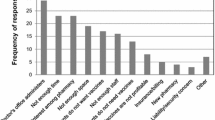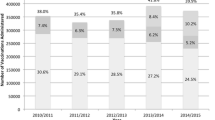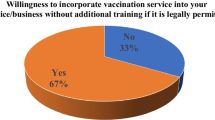Abstract
New York State (NYS) passed legislation authorizing pharmacists to administer immunizations in 2008. Racial/socioeconomic disparities persist in vaccination rates and vaccine-preventable diseases such as influenza. Many NYS pharmacies participate in the Expanded Syringe Access Program (ESAP), which allows provision of non-prescription syringes to help prevent transmission of HIV, and are uniquely positioned to offer vaccination services to low-income communities. To understand individual and neighborhood characteristics of pharmacy staff support for in-pharmacy vaccination, we combined census tract data with baseline pharmacy data from the Pharmacies as Resources Making Links to Community Services (PHARM-Link) study among ESAP-registered pharmacies. The sample consists of 437 pharmacists, non-pharmacist owners, and technicians enrolled from 103 eligible New York City pharmacies. Using multilevel analysis, pharmacy staff who expressed support of in-pharmacy vaccination services were 69% more likely to support in-pharmacy HIV testing services (OR, 1.69; 95% CI 1.39–2.04). While pharmacy staff who worked in neighborhoods with a high percent of minority residents were less likely to express support of in-pharmacy vaccination, those in neighborhoods with a high percent of foreign-born residents were marginally more likely to express support of in-pharmacy vaccination. While educational campaigns around the importance of vaccination access may be needed among some pharmacy staff and minority community residents, we have provided evidence supporting scale-up of vaccination efforts in pharmacies located in foreign-born/immigrant communities which has potential to reduce disparities in vaccination rates and preventable influenza-related mortality.
Similar content being viewed by others
References
Centers for Disease Control and Prevention. Seasonal influenza: The disease. 2009.
Chen JY, Diamant A, Pourat N, Kagawa-Singer M. Racial/ethnic disparities in the use of preventive services among the elderly. Am J Prev Med. 2005; 29(5): 388–395.
Hebert PL, Frick KD, Kane RL, McBean AM. The causes of racial and ethnic differences in influenza vaccination rates among elderly Medicare beneficiaries. Health Serv Res. 2005; 40(2): 517–537.
Marin MG, Johanson WG Jr, Salas-Lopez D. Influenza vaccination among minority populations in the United States. Prev Med. 2002; 34(2): 235–241.
Molinari NA, Ortega-Sanchez IR, Messonnier ML, et al. The annual impact of seasonal influenza in the US: measuring disease burden and costs. Vaccine. 2007; 25(27): 5086–5096.
Centers for Disease Control and Prevention. National, state, and local area vaccination coverage among children aged 19–35 months--United States, 2007. MMWR Morb Mortal Wkly Rep. 2008; 57(35): 961–966.
Immunization Action Coalition. States authorizing pharmacists to vaccinate. Saint Paul, MN. 2009.
Bryant WK, Ompad DC, Sisco S, et al. Determinants of influenza vaccination in hard-to-reach urban populations. Prev Med. 2006; 43(1): 60–70.
Vlahov D, Coady MH, Ompad DC, Galea S. Strategies for improving influenza immunization rates among hard-to-reach populations. J Urban Health. 2007; 84(4): 615–631.
Steyer TE, Ragucci KR, Pearson WS, Mainous AG 3rd. The role of pharmacists in the delivery of influenza vaccinations. Vaccine. 2004; 22(8): 1001–1006.
Grabenstein JD. Overcoming immunization disparities based on ethnicity. Pharm Pract Manag Q. 2001; 20(3): 23–30.
Smedley B, Stith A, Nelson A. Editors. Unequal treatment: Confronting racia/ethnic disparities in health care. Committee on Understanding and Eliminating Racial and Ethnic Disparities in Health Care, Board on Health Sciences Policy, Institute of Medicine. Washington, D.C.; 2002.
Rivera AV, Blaney S, Crawford ND, et al. Individual- and neighborhood-level factors associated with nonprescription counseling in pharmacies participating in the New York State Expanded Syringe Access Program. J Am Pharm Assoc. 2010; 50(5): 580–587.
SUDAAN Example Manual, Release 9.0 Research [computer program]. Triangle Park, NC: Research Triangle Institute; 2004.
Kamal KM, Madhavan SS, Maine LL. Pharmacy and immunization services: pharmacists’ participation and impact. J Am Pharm Assoc. 2003; 43(4): 470–482.
Hogue MD, Grabenstein JD, Foster SL, Rothholz MC. Pharmacist involvement with immunizations: a decade of professional advancement. J Am Pharm Assoc. 2006; 46(2): 168–179. quiz 179–182.
Ndiaye SM, Madhavan S, Washington ML, et al. The use of pharmacy immunization services in rural communities. Public Health. 2003; 117(2): 88–97.
Coffin PO, Ahern J, Dorris S, Stevenson L, Fuller C, Vlahov D. More pharmacists in high-risk neighborhoods of New York City support selling syringes to injection drug users. J Am Pharm Assoc (Wash). 2002; 42(6 Suppl 2): S62–S67.
Geronimus AT, Bound J. Use of census-based aggregate variables to proxy for socioeconomic group: evidence from national samples. Am J Epidemiol. 1998; 148(5): 475–486.
Author information
Authors and Affiliations
Corresponding author
Additional information
This research is supported by the National Institutes on Drug Abuse [R01 DA022144-01].
Rights and permissions
About this article
Cite this article
Crawford, N.D., Blaney, S., Amesty, S. et al. Individual- and Neighborhood-Level Characteristics Associated with Support of In-Pharmacy Vaccination among ESAP-Registered Pharmacies: Pharmacists’ Role in Reducing Racial/Ethnic Disparities in Influenza Vaccinations in New York City. J Urban Health 88, 176–185 (2011). https://doi.org/10.1007/s11524-010-9541-6
Published:
Issue Date:
DOI: https://doi.org/10.1007/s11524-010-9541-6




